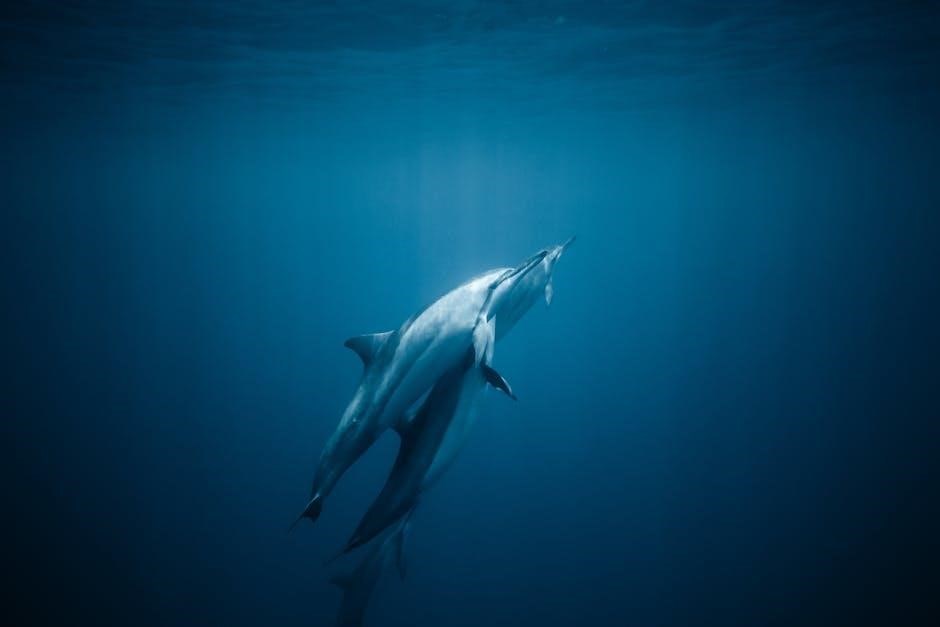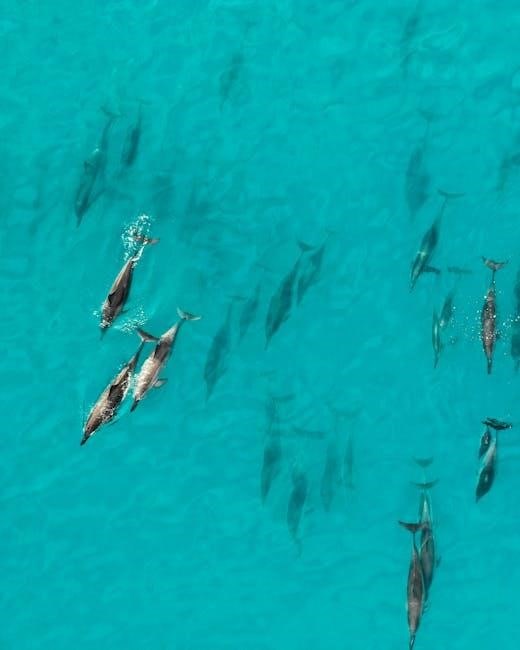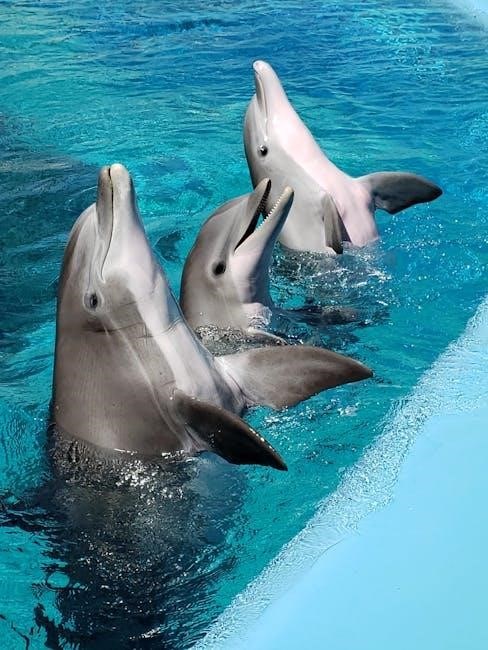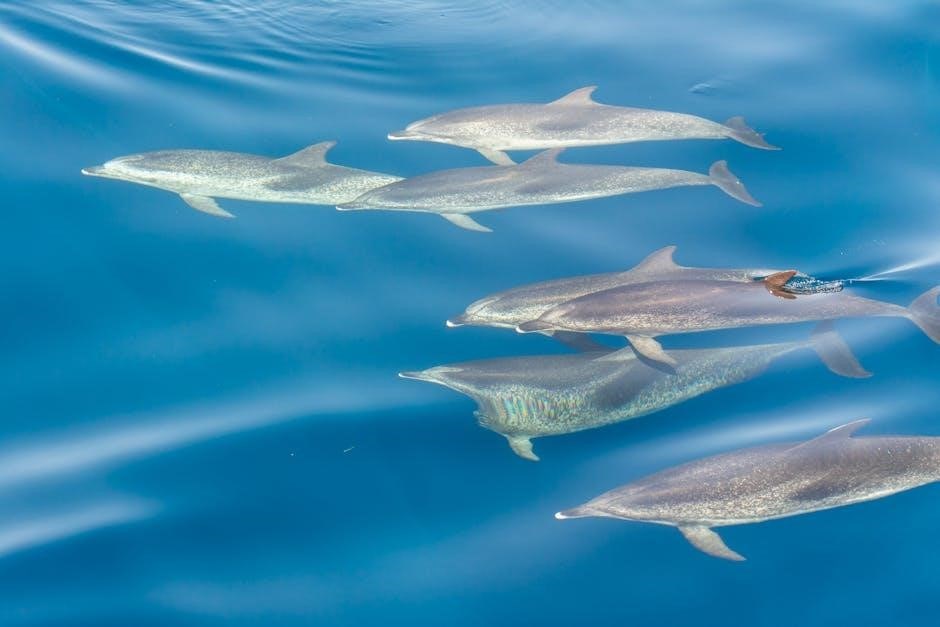dolphins filetype:pdf
- Published
- in PDF
Dolphins are aquatic mammals of the infraorder Cetacea with clever nature always helping others in need with unique characteristics and behavior patterns every day naturally․
Definition and Classification
Dolphins are aquatic mammals of the infraorder Cetacea‚ which constitutes five families‚ including oceanic dolphins and river dolphins‚ with a total of 40 extant species named as dolphins‚ they are divided into several genera and are classified based on their physical characteristics and habitats‚ the classification of dolphins is an ongoing process‚ with new species being discovered and old ones being reclassified‚ dolphins are closely related to whales and porpoises‚ and are part of the order Cetacea‚ which is a group of marine mammals that also includes whales and porpoises‚ the definition and classification of dolphins is important for understanding their evolution‚ behavior and conservation status‚ and for developing effective conservation strategies․
Characteristics and Behavior
Dolphins are known for their clever and social nature‚ they look after other dolphins when they are ill‚ care for very young dolphins and protect the weakest dolphins‚ they are also playful and friendly to humans‚ dolphins have a unique way of communicating with each other using clicks and whistles‚ they are highly intelligent and have been observed exhibiting complex behaviors such as cooperation and problem-solving‚ dolphins are also known for their agility and speed‚ they can swim at speeds of up to 60 kilometers per hour‚ making them one of the fastest swimming animals in the ocean‚ their behavior and characteristics make them one of the most fascinating creatures in the marine world‚ with a range of interesting and complex social behaviors․

Dolphin Species and Habitat
Dolphins inhabit oceans and rivers with various species and habitats around the world naturally every day with unique characteristics and behaviors always․
Number of Species and Distribution

There are currently 42 species of dolphins and seven species of porpoises‚ with dolphins ranging in size and distribution across the globe․
They can be found in every ocean on Earth‚ and there are freshwater species of dolphins that inhabit rivers in South Asian and South American regions․
The distribution of dolphin species varies greatly‚ with some species being found in shallow coastal waters‚ while others prefer deeper ocean waters․
Dolphins are marine mammals that must surface to breathe air and give birth to live young‚ and their distribution is often influenced by the availability of food and suitable habitat․
Overall‚ the number of dolphin species and their distribution is a testament to the diversity and complexity of these fascinating creatures․
Habitat and Geographic Range
Dolphins can be found in various aquatic habitats‚ including oceans‚ seas‚ and rivers‚ with a wide geographic range that spans across the globe․
They inhabit both warm and cold waters‚ from the equatorial regions to the polar seas‚ and can be found in shallow coastal waters‚ estuaries‚ and deep ocean waters;
The geographic range of dolphins is influenced by factors such as food availability‚ water temperature‚ and salinity‚ with some species being found in specific regions‚ such as the Indian River dolphins in South Asia․
Dolphins are also known to migrate to different areas in search of food‚ shelter‚ and mates‚ with some species traveling long distances across entire ocean basins․
Their habitat and geographic range are diverse and complex‚ reflecting their adaptability and ability to thrive in different environments․

Dolphin Biology and Reproduction
Dolphins are marine mammals with unique biological characteristics always giving birth to live young naturally every time with proper care and nutrition always․
Physiological Characteristics
Dolphins have a number of physiological characteristics that enable them to thrive in their aquatic environment‚ including a streamlined body and a thick layer of blubber to keep warm․ They also have a highly efficient respiratory system‚ allowing them to conserve oxygen while diving and foraging for food․ Their circulatory system is also specially adapted to conserve heat and oxygen‚ with a unique system of blood vessels that helps to regulate their body temperature․ Additionally‚ dolphins have a number of sensory adaptations‚ including a highly developed sense of echolocation‚ which allows them to navigate and hunt in their environment with ease and precision‚ making them well-suited to their aquatic lifestyle and enabling them to survive and thrive․
Pregnancy and Birth
Dolphins have a relatively long pregnancy period‚ typically lasting around 12-14 months‚ with some species having a gestation period of up to 17 months․ During this time‚ the female dolphin will nurture her developing calf‚ providing it with the necessary nutrients and care․ When the time comes for birth‚ the female dolphin will give birth to a single calf‚ which will be born tail first and will quickly swim to the surface to take its first breath․ The newborn calf will then be cared for by its mother‚ who will provide it with milk and protection‚ teaching it essential skills and helping it to develop and grow into a healthy and strong young dolphin over time․ This process is crucial for the survival of the species․

Dolphin Social Behavior and Intelligence
Dolphins exhibit complex social behaviors and intelligence always interacting with each other in unique ways every day naturally and freely․
Social Structure and Communication
Dolphins live in groups with complex social structures‚ communicating with each other using clicks‚ whistles‚ and body language‚ forming long-lasting relationships and cooperating to achieve common goals․ They have been observed showing signs of cultural behaviors‚ passing on traditions and behaviors to younger generations․ Their communication skills are highly developed‚ allowing them to convey information about food‚ predators‚ and social interactions․ Dolphins also use contextual behaviors to convey specific information‚ such as warning other dolphins of potential threats․ Their social structure and communication patterns are essential to their survival and success in their aquatic environment‚ allowing them to thrive in a variety of ecosystems․ Dolphins are highly social creatures that rely on their communication and social skills to navigate their world․
Intelligence and Problem-Solving
Dolphins are known for their exceptional intelligence and problem-solving abilities‚ often demonstrating innovative solutions to complex challenges․ They have been observed using tools to help them forage for food and navigate their environment․ Dolphins have also been known to exhibit self-awareness‚ recognizing themselves in mirrors and demonstrating an understanding of their own bodies․ Their intelligence is likely due to the large size of their brains relative to their body size‚ as well as the complexity of their social structures․ Dolphins have been observed solving problems in creative ways‚ such as using sponges to protect their noses while foraging for food․ Their intelligence and problem-solving abilities are likely key factors in their success and adaptability in a variety of aquatic environments‚ allowing them to thrive in diverse ecosystems․ They continue to fascinate and inspire researchers․
